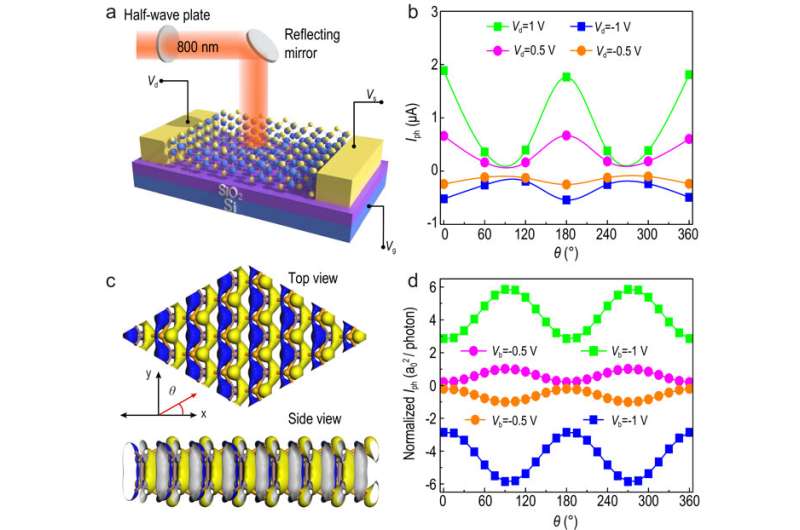High performance polarization sensitive photodetectors on 2D semiconductor

Polarization-sensitive photodetectors (PSPDs) have significant applications in both military and civil areas. However, the current commercial PSPDs require the aid of optical devices such as polarizers and phase retarders to pick up the polarization information of light. It is still an arduous task for realizing filter-free PSPDs. Scientists from China and South Korea prepare the stable layered β-InSe and achieve high performance filter-free PSPDs with high photocurrent anisotropic ratio of 0.70.
To extract the polarization information of incident light, polarization-sensitive photodetectors (PSPDs) have significant practical applications in both military and civil areas, like bio-imaging, remote sensing, night vision, and helmet-mounted sights for fighter pilots. Optical filters combined with polarizers are usually needed for traditional photodetectors to realize polarized light detection. But this will increase the size and complexity of devices.
To obtain a small-size PSPD, one-dimensional (1D) nanomaterials with geometrical anisotropy, such as nanowires, nanoribbons and nanotubes, have been used as the sensitive materials for PSPDs, which can directly identify the polarization information of incident light without any optical filters and polarizers. However, it is not an easy task for patterning and integrating these 1D nanochannels for mass production of PSPDs.
Atomically layered two-dimensional (2D) semiconductors with low crystal symmetry have great potential in micro-nano PSPDs recently due to their intrinsically in-plane anisotropic properties. For example, SnS, ReS2, GeS2, GeAs2, AsP and black phosphorus (BP) exhibit an obvious in-plane anisotropy behavior in carrier transport, thermal conductivity, electrical conductivity, thermoelectric transport and optical absorption processes. They have potential applications in polarization sensitive photodetectors, polarization ultrafast lasers, polarization field-effect transistors and polarization sensors. Among them, BP-based PSPDs have the highest photocurrent anisotropy ratio of 0.59, benefitting from its high carrier mobility and the strong in-plane anisotropy coming from the low-symmetry puckered honeycomb crystal structure.
But BP-based optoelectronic devices are have a difficult ambient degradation problem. 2D layered indium selenide (InSe), which also has high carrier mobility and is more stable than BP in atmospheric environment, have potential applications in high performance optoelectronic and electronic devices. In addition, the anisotropic optical and electronic properties of 2D layered InSe were demonstrated in 2019. Notably, InSe crystal has three specific polytypes, which are in β, γ, and ε phases, respectively. Among them, InSe in γ-phase and ε-phase belong to symmetry groups. Only the InSe in β-phase (β-InSe) belongs to the nonsymmetry point group, indicating that β-InSe exhibits better anisotropic optoelectronic properties than the other two polytypes.
In order to achieve high-performance PSPDs with good stability, the advanced optoelectronic devices research team led by Professor Han Zhang from the Shenzhen University prepare the stable p-type 2D layered β-InSe via temperature gradient method. The anisotropic nature of the β-InSe was revealed by angle-resolved Raman. The intensity of the out-of-plane and in-plane vibrational modes exhibit pronounced periodic variations with the polarization angle of the excitations. Additionally, the good stability of β-InSe flakes and their FET devices was proved by long-time AFM measurement and multi-repeat electrical performance test.
The experimental results are in good agreement with the theoretical calculations that there are strong anisotropic transport and polarization-sensitive photoresponse in 2D-layered β-InSe flakes. The photocurrent anisotropic ratio of the β-InSe photodetector reaches 0.70, which ranks high among the single 2D material based PSPDs. The strong anisotropic Raman, transport and photoresponse properties of the β-InSe have potential applications in filter-free polarization sensitive photodetectors.
More information: Zhinan Guo et al, High performance polarization sensitive photodetectors on two-dimensional β-InSe, National Science Review (2021). DOI: 10.1093/nsr/nwab098
Provided by Science China Press




















